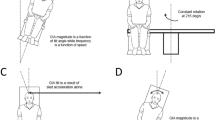Abstract
Dual search coils were used to record horizontal, vertical and torsional eye movement components of one eye during nystagmus caused by off-center yaw rotation (yaw centrifugation). Both normal healthy human subjects (n=7) and patients with only one functioning labyrinth (n=12) were studied in order to clarify how the concomitant linear acceleration affected the nystagmus response. Each subject was seated with head erect on the arm of a fixed-chair human centrifuge, 1 m away from the center of the rotation, and positioned to be facing along a radius; either towards (facing-in) or away from (facing-out) the center of rotation. Both yaw right and yaw left angular accelerations of 10°s–2 from 0 to 200°/s were studied. During rotation a centripetal linear acceleration (increasing from 0 to 1.24×g units) was directed along the subject’s naso-occipital axis resulting in a shift of the resultant angle of the gravitoinertial acceleration (GIA) of 51° in the subject’s pitch plane and an increase in the total GIA magnitude from 1.0 to 1.59×g. In normal subjects during the angular acceleration off-center there were, in addition to the horizontal eye velocity components, torsional and vertical eye velocities present. The magnitude of these additional components, although small, was larger than observed during similar experiments with on-center angular acceleration (Haslwanter et al. 1996), and the change in these components is attributed to the additional effect of the linear acceleration stimulation. In the pitch plane the average size of the shift of the axis of eye velocity (AEV) during the acceleration was about 8° for a 51° shift of the GIA (around 16% of the GIA shift) so that the AEV-GIA alignment was inadequate. There was a very marked difference in the size of the AEV shift depending on whether the person was facing-in [AEV shift forward (i.e. non-compensatory) of about 4°] or facing-out [AEV shift forward (i.e. compensatory) of around 12°]. The linear acceleration decreased the time constant of decay of the horizontal component of the post-rotatory nystagmus: from an average of 24.8°/s facing-in to an average of 11.3°/s facing-out. The linear acceleration dumps torsional eye velocity in an manner analogous to, but independent of, the dumping of horizontal eye velocity. Patients with UVD had dramatically reduced torsional eye velocities for both facing-in and facing-out headings, and there was little if any shift of the AEV in UVD patients. The relatively small effects of linear acceleration on human canal-induced nystagmus found here confirms other recent studies in humans (Fetter et al. 1996) in contrast to evidence from monkeys and emphasizes the large and important differences between humans and monkeys in otolith-canal interaction. Our results confirm the vestibular control of the axis of eye velocity of humans is essentially head-referenced whereas in monkeys that control is essentially space-referenced.
Similar content being viewed by others
Author information
Authors and Affiliations
Additional information
Received: 22 September 1997 / Accepted: 30 June 1998
Rights and permissions
About this article
Cite this article
Curthoys, I., Haslwanter, T., Black, R. et al. Off-center yaw rotation: effect of naso-occipital linear acceleration on the nystagmus response of normal human subjects and patients after unilateral vestibular loss. Exp Brain Res 123, 425–438 (1998). https://doi.org/10.1007/s002210050587
Issue Date:
DOI: https://doi.org/10.1007/s002210050587




